Football/Soccer Session (Moderate): 4-3-3 System Overview (Blue Star Major 2009) 2024-2025 Season
Profile Summary

| Name: | Braxton Rathod |
|---|---|
| City: | Saint Louis |
| Country: | United States of America |
| Membership: | Adult Member |
| Sport: | Football/Soccer |
Description
The purpose of this guide is to provide a deeper understanding of the principles and objectives behind our training and tactical approach. It is not about memorizing every detail but rather learning why we emphasize specific actions and coaching points. This document serves as a roadmap for our style of play and system, illustrating how each phase contributes to our overall strategy.
For additional insight into the 4-3-3 system and its application by professional teams, visit:
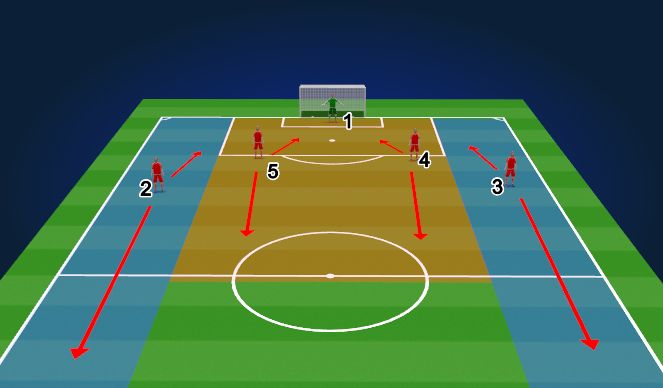
See the guidance at the top of this page to understand why you are not seeing interactive Football/Soccer images.

Defensive Responsibilities
Defensive Responsibilities
Back 4 (5 and 4 - Center Backs)
Defensively:
- Maintain shape and remain connected to each other and the outside backs.
- Be assertive in tackles and strong in the air.
- Hold the defensive line and protect the goal at all costs.
Provide a safe option for maintaining possession and ensure a constant drop point.
Step into the midfield to overload if necessary, recognizing when the opposition leaves gaps.
Stay composed on the ball and aware of counter-attacking threats.
Player References:
Virgil Van Dijk, Alessandro Bastoni, Dean Huijsen.
2 and 3 (Outside Backs)
Defensively:
Stay connected to the strong-side center back to ensure compactness.
Close down opposition wide players and defend 1v1 in wide areas.
Tuck in as the weak-side outside back or step up as needed, depending on the opponent's setup.
In Possession:
Push high to offer width and create overloads, understanding when to overlap versus underlap.
Provide crosses, overlap or underlap runs, and be dangerous in the attacking phase.
Decision-making is key: recognize when to stay back to guard against counters.
Player References:
2: High and wide
(e.g., Kyle Walker, Jeremie Frimpong).
3: Inverted pivot
(e.g., Oleksandr Zinchenko, Josko Gvardiol).
Goalkeeper (1)
Defensively:
Act as a last resort drop and be comfortable coming out of the box to support.
Anticipate plays to cut off through balls and initiate counterattacks quickly.
In Possession:
- Participate in the build-up and play as a sweeper-keeper when necessary, ensuring composure under pressure.
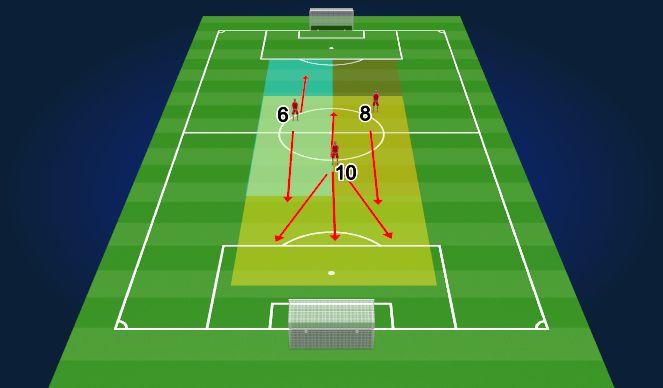
See the guidance at the top of this page to understand why you are not seeing interactive Football/Soccer images.

Midfield Responsibilities
Midfield Responsibilities
6 (Defensive Midfielder)
Defensively:
- Anchor the midfield and provide a screen in front of the center backs.
- Be the first line of defense against counterattacks, intercepting passes when possible.
In Possession:
Stay composed under pressure and facilitate play out of the back, ensuring accurate distribution.
Understand when to drop between center backs to create a numerical advantage.
Player References: Rodri, Declan Rice, Ryan Gravenberch.
8 (Box-to-Box Midfielder)
Defensively:
Stay connected to the other midfielders while marking passing lanes.
Contribute to defensive coverage, especially in wide areas when the outside back is forward.
In Possession:
Drive through lines and find advanced pockets of space to combine and create opportunities.
Maintain stamina and awareness to support both defensive and attacking plays.
Player References: Jude Bellingham, Frenkie de Jong, Nicolò Barella.
10 (Attacking Midfielder)
Defensively:
Recover quickly and contribute to pressing in advanced areas.
Recognize opportunities to intercept and disrupt opposition build-up.
In Possession:
Look to combine with forwards, make creative runs, and break down the opponent’s defensive line.
Use vision and awareness to exploit gaps in the opposition's defense.
Player References: Florian Wirtz, Xavi Simons, Arda Guler, Dominik Szoboszlai.
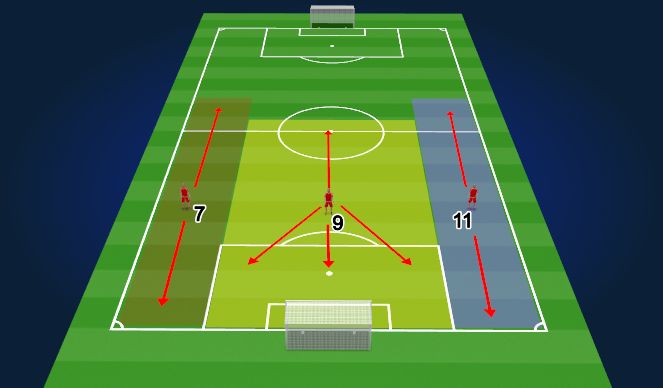
See the guidance at the top of this page to understand why you are not seeing interactive Football/Soccer images.

Forward Responsibilities
Forward Responsibilities
7 and 11 (Wingers)
Defensively:
Initiate the press and force opponents to wide areas.
Track back to support outside backs when necessary.
In Possession:
7: Operate in half-spaces, combining with midfielders and the 9. Recognize when to cut inside versus hold position.
11: Hold width, attack 1v1, and deliver crosses. Look for opportunities to make diagonal runs into the box.
Player References:
7: Mohamed Salah, Raphinha, Bukayo Saka.
11: Vinícius Júnior, Rodrygo, Khvicha Kvaratskhelia, Cody Gakpo, Luis Diaz.
9 (Striker)
Defensively:
Lead the press and block central passing lanes.
Be proactive in initiating defensive actions to disrupt the opponent’s build-up.
In Possession:
Combine with wingers, make inside-out runs, and finish crosses.
Act as a focal point for hold-up play and creativity, drawing defenders out of position.
Understand when to drop deep to link play versus staying forward to threaten the goal.
Player References: Liam Delap, Endrick, Victor Osimhen, Robert Lewandowski.
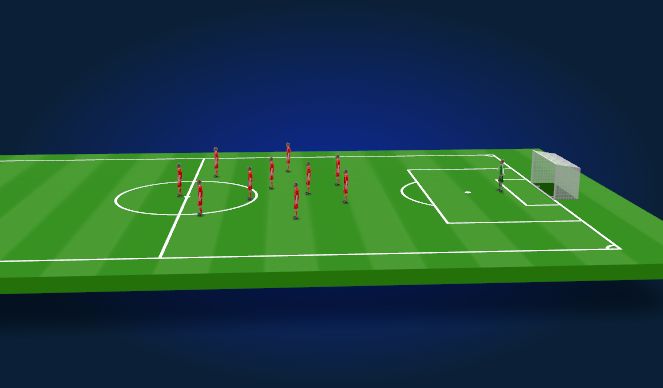
See the guidance at the top of this page to understand why you are not seeing interactive Football/Soccer images.

Phases of Play - Out of Possession
Phases of Play
Out of Possession
Back Four:
Operate zonally, with center backs staggered based on ball position.
Outside backs cover wide areas to limit opposition wingers.
Midfield Three:
Function as a tight triangle to maintain compactness and force play centrally.
Aggressively attack the ball to disrupt opposition build-up.
Forward Three:
Initiate the press, forcing opponents into wide areas and cutting off central passing lanes.
Defensive General Concepts
Combination Man/Zone
Defending in a 4-3-3 should be done primarily with zonal defending.
Players are not solely responsible for marking an individual opponent but instead are responsible for filling areas of space and marking any opponents in those spaces.
Zonal defending allows the team to keep a better defensive shape and reduces some of the physical demands of man-marking.
Because the 4-3-3 does not have outside midfielders, the back four must not play with a sweeper-stopper system.
Instead, the two center backs are always staggered depending on where the ball is.
If the ball is on the left, the right center back is deeper than the left center back.
Playing with two center backs will allow the outside backs to step into wide spaces more effectively defensively to address the weakness within the system.
Inside the penalty box, the system switches to purely man-to-man marking. Proximity to the goal does not allow for space to zone.
Midfield General Concepts
The midfield three will also function under zonal principles; however, this group must be much more aggressive and attack the ball on defense.
The work rate of the three midfield players is going to determine if this system works.
These three players are primarily responsible for the middle vertical third of the field—the area between the sides of the penalty boxes.
Wide space must normally be covered by outside backs and wingers.
The outside midfielders will be pinched in, so that the midfield works as a tight triangle wherever they go on the field.
If the midfielders get stretched too wide, the team will get beaten up the middle, as the central midfielder will constantly be numbers down defensively.
In the attacking and midfield thirds of the field, this group should force the ball centrally, where the team will have numbers up most of the time.
Forcing the ball inside will reduce space for attackers to play in and is uncomfortable for most outside backs.
Turnovers in this area create natural counter-attack opportunities.
One midfield player must always be in the “hole” in front of the center backs.
This player is most important to prevent counters up the middle of the field and to “protect” the center backs.
This player acts partially as a screen, preventing balls into the feet of center forwards.
Coordination Between the Backs and Midfield
The inherent defensive weakness in the 4-3-3 is the lack of outside midfielders.
If this outside midfield space is not defended appropriately, the team will have major difficulties.
If our wing backs are able to cover wide areas properly, our midfield three should not be stretched wide.
Good communication between the defense and midfield is required for this to happen successfully.
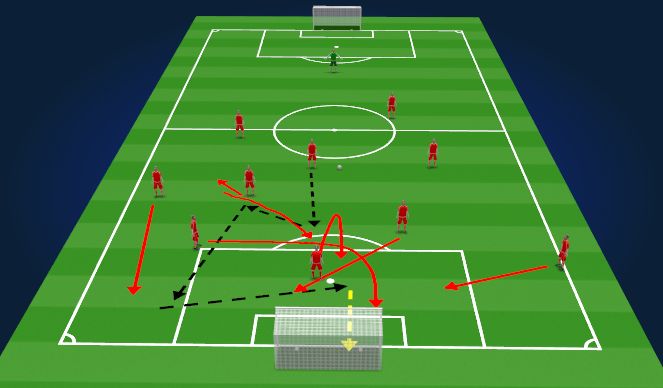
See the guidance at the top of this page to understand why you are not seeing interactive Football/Soccer images.

Phases of Play - In Possession
In Possession
Back Four:
Center backs provide stability and distribute to midfielders, maintaining calm under pressure.
Wing backs push high to offer width and overlap or underlap as needed.
Midfield Three:
6 stays deeper to cover defensive transitions, recognizing when to step into attacking spaces.
8 and 10 move into advanced spaces, with the 8 connecting transitions and the 10 creating scoring opportunities.
Forward Three:
Maintain width and stretch the defensive line.
9 drops to create space, while wingers attack diagonally behind.
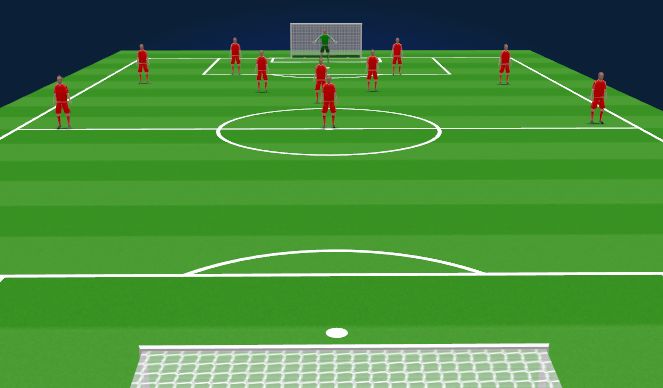
See the guidance at the top of this page to understand why you are not seeing interactive Football/Soccer images.

Keys to Success
Specific Adjustments for This Season
The left outside back (3) will invert into the midfield, creating a double pivot with the 6 to enhance build-up play.
The 8 will push higher into advanced pockets, with the 10 joining the attack to increase goal-scoring opportunities.
The primary attacking focus will shift to the right side, utilizing overloads and combinations with the 7, 9, and 8. Clear decision-making is essential to execute these combinations effectively.
Key Concepts for Success
- Communication: Essential between all lines to maintain structure and adapt dynamically. Players should communicate clearly and consistently.
Awareness: Players must understand their role in each phase and anticipate transitions. Decision-making improves with greater awareness of the game state.
Decision-Making: A critical element in both in-possession and out-of-possession scenarios. Players need to assess their options quickly and make the best choices under pressure.
Work Rate: Especially from the midfield three to ensure compactness and coverage. High intensity is required both in pressing and recovery runs.








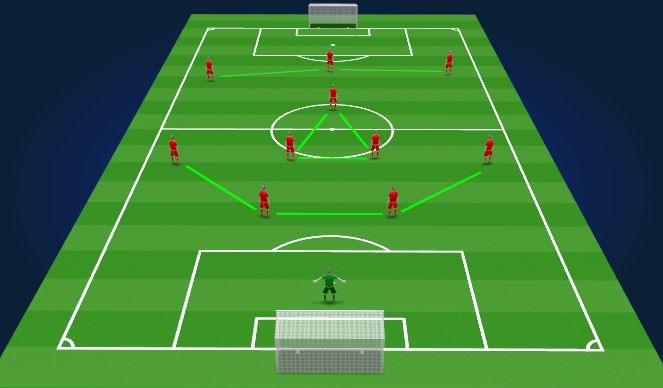
 Play animation
Play animation Play step-by-step
Play step-by-step Repeat (toggle)
Repeat (toggle) Full Screen
Full Screen Pause
Pause Stop
Stop
System overview
4-3-3 System Overview
The 4-3-3 formation is an ideal system for young players to learn due to its tactical flexibility and developmental benefits. This formation encourages players to understand spatial awareness, improve their positional play, and develop a deeper understanding of transitions between attack and defense. It promotes technical skill development, as players are consistently involved in both offensive and defensive phases, and fosters teamwork by emphasizing interconnected roles across the field. With minor adjustments, it can shift into a more defensive 4-5-1 or a more attacking 4-2-4. These transitions are easier to implement compared to other formations, making the 4-3-3 a versatile and dynamic approach.
In possession, our system will transform into either a 2-4-4 or a 3-4-3, depending on the phase of play. This fluidity allows players to adapt to game scenarios effectively. Understanding the rationale behind these transitions helps players recognize when and why to make positional adjustments. Players familiar with the basic concepts of every line in the system, both in and out of possession, will be better prepared to make smart movements and quick decisions during matches. These concepts include maintaining positional discipline, recognizing transitions, executing precise passing sequences, and adapting to tactical shifts like pressing or dropping deep. Understanding these fundamentals ensures players can react confidently to the dynamic flow of the game, enhancing both individual and team performance.